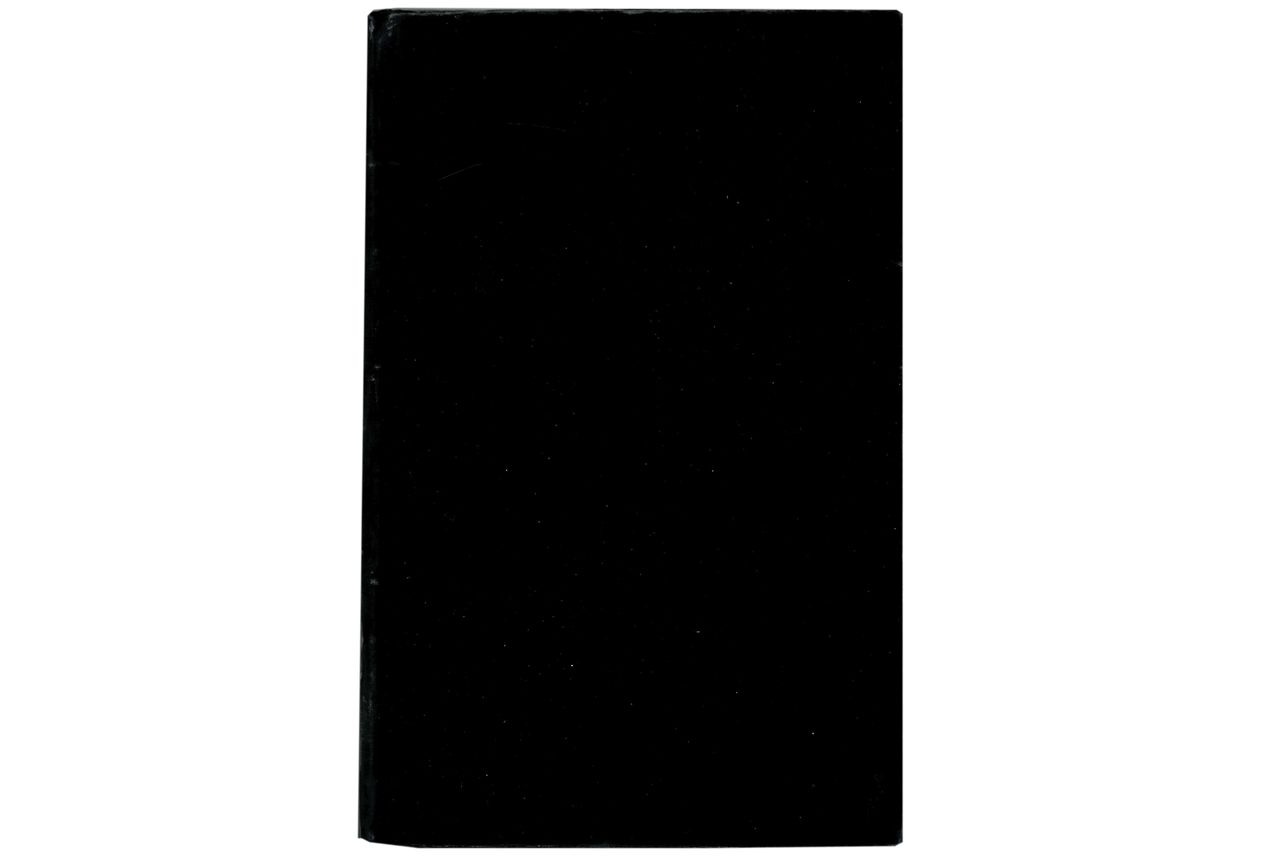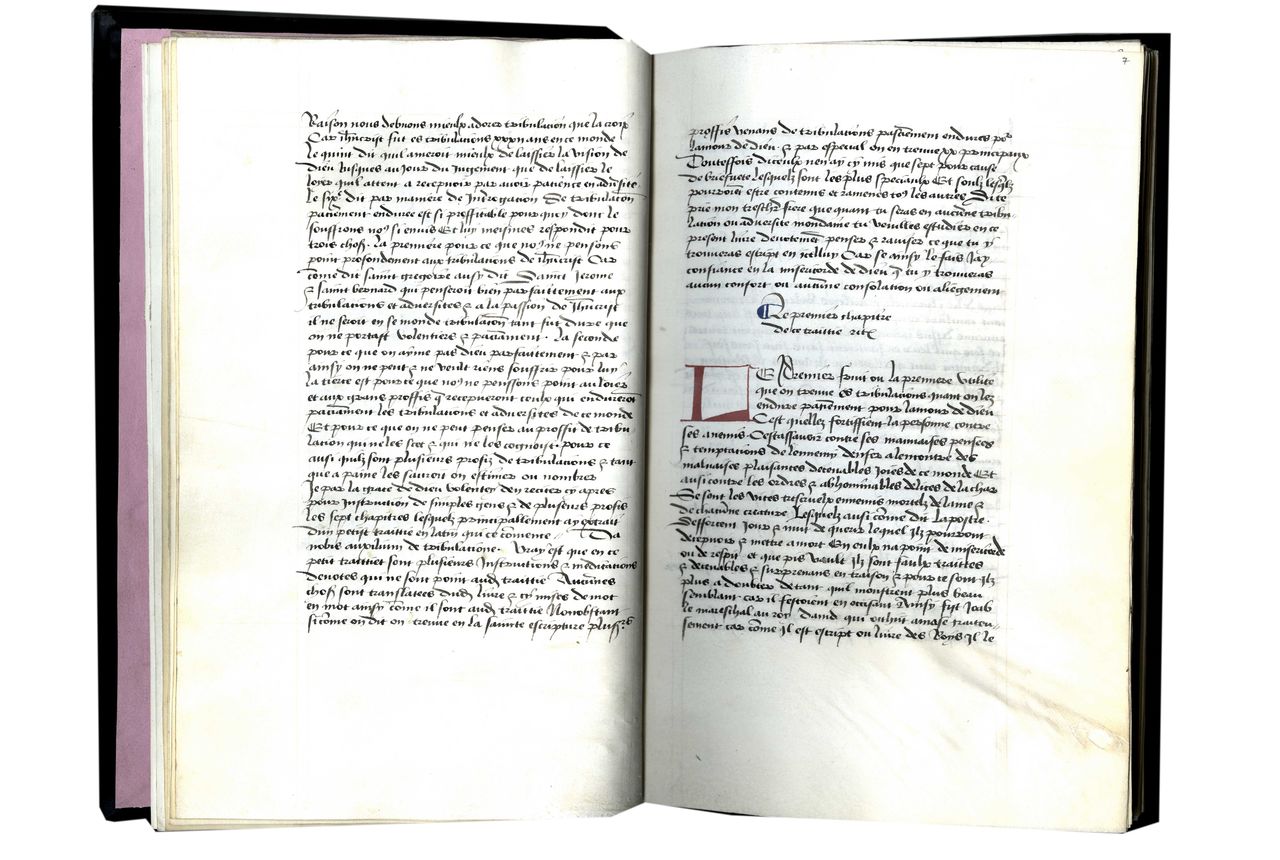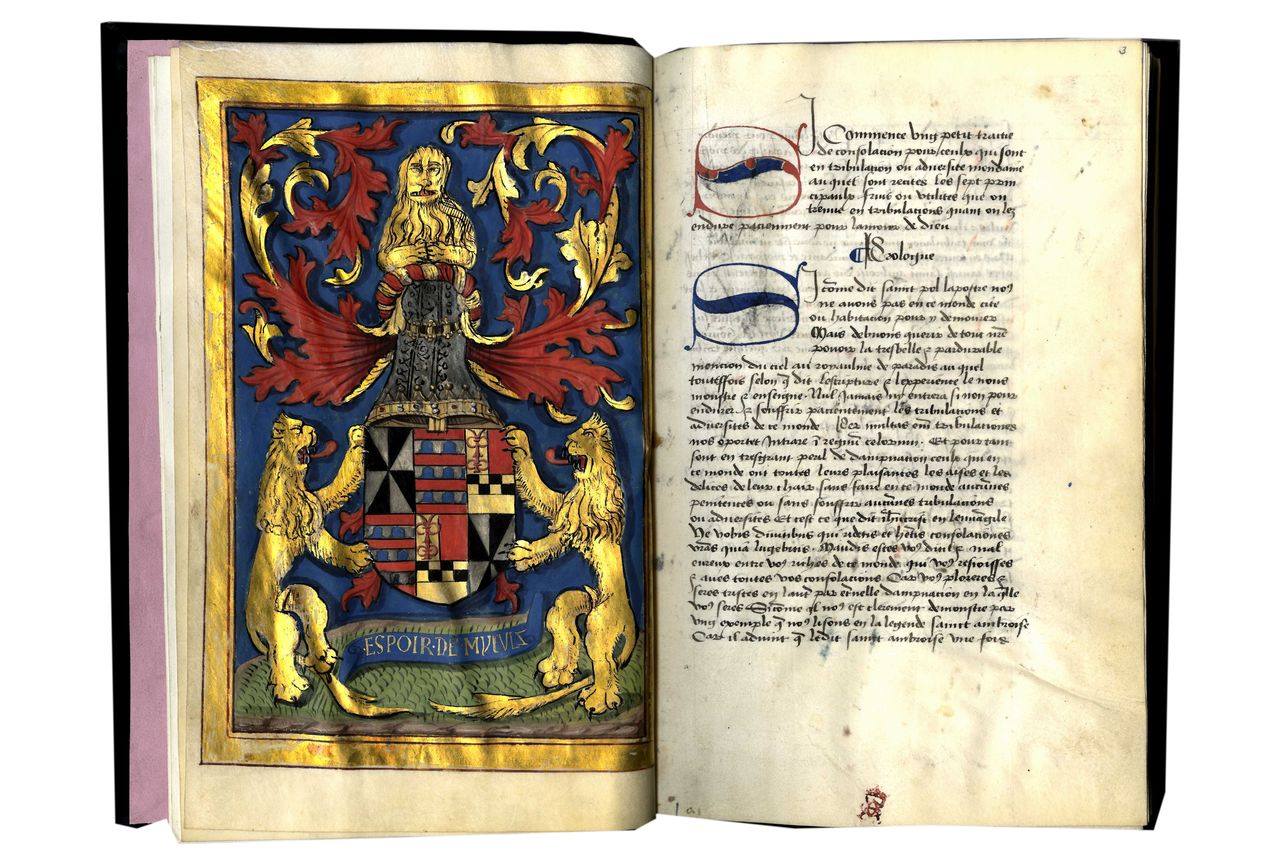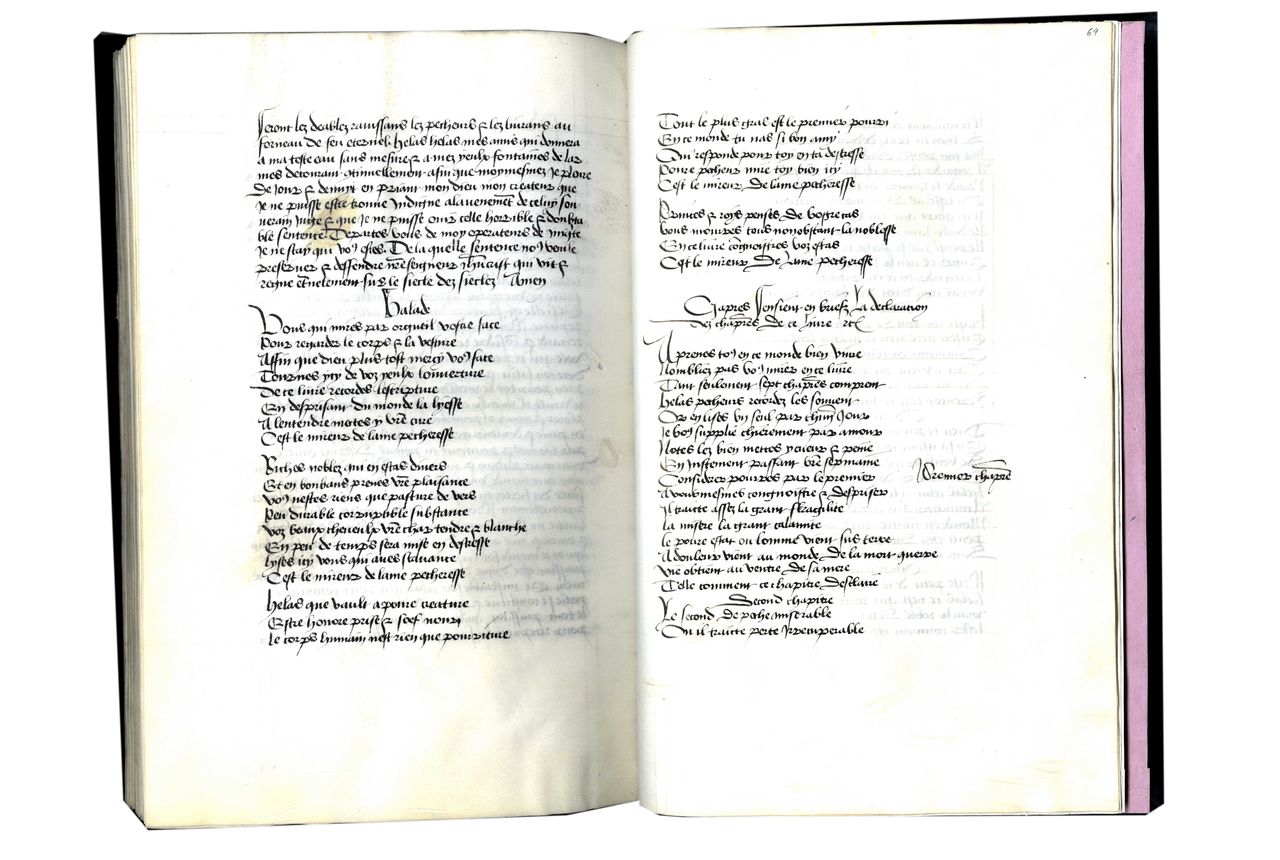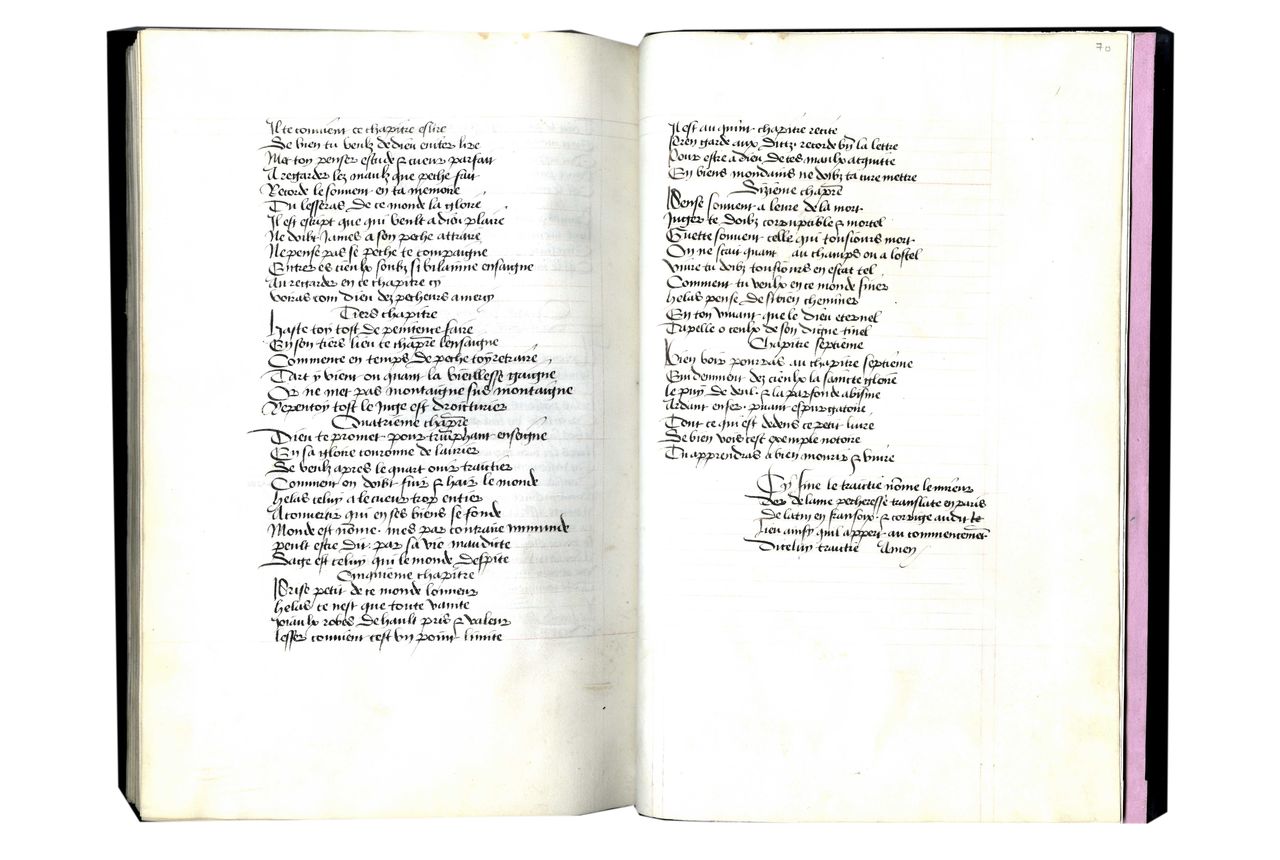70 folios, complete (collation i8 [7+1, inserted ii], ii-xii8), catchwords, some signatures, written in dark brown ink in a Gothic bâtarde bookhand on up to 34 lines (justification 180 x 110 mm), parchment ruled in red, blue paragraph marks, 18 large initials parti-colored in red and blue or simply painted red or blue, inserted leaf in first quire with full-page heraldic composition in gold, silver, red, blue and black, gold slightly rubbed, some off-setting from heraldic painted composition to opening text page, slight staining in upper margin and into three lines of text ff. 68-69. Bound in modern nineteenth-century blue velvet over wooden boards, pink paper pastedowns and endleaves, edges gilt. Dimensions 274 x 175 mm.
Elegant manuscript containing two works of spiritual and moral edification in French translation. The first text is known in only five extant manuscript and is still unedited. There is neither a modern critical edition of the second text, nor a complete census of the existing manuscripts; the copy here was apparently made from an incunable edition of c. 1490. This manuscript begins with a remarkable added full-page illuminated frontispiece with the coat of arms and motto of Louis de Grolée (fl. late fifteenth-early sixteenth century), the abbot of Bonnevaux and Saint-Pierre de Vienne. Louis was the proud owner of exceptional books including volumes once owned by King Louis IX and Jean, Duc de Berry; the story of how he acquired these manuscripts, and his practice of personalizing them with illuminated heraldic compositions, is waiting to be told.
Provenance
1. Copied in France (perhaps northeastern?) based on script and linguistic characteristics, as well as internal evidence. A terminus a quo date of 1482 is suggested because of the dates of activity of Antoine Caillaut, printer of the second work, active in Paris from 1482 to 1506. The manuscript was necessarily copied after 1482, probably in the 1490s when the imprint of the Miroir d’or de l’ame pecheresse was issued in Paris with the same ballad and acrostic verse revealing the names of the printers placed at the end (Pellechet, 1909, tome III, no. 4326).
2. Belonged to Louis de Grolée (fl. late fifteenth-early sixteenth century), who added the full-page illuminated frontispiece to the manuscript on f. 2v: Coupé de 1, parti de 6. quartiers, 3 en chef et 3 en pointe, au 1er du chef et au 3e de la pointe gironné d’or et de sable [Grolée], au 2e du chef et 1er de la pointe, de gueules à 3 fasces d’azur, chargées la 1ere de 3 cloches d’argent, la 2e de 2 et la 3e de 1 [Bressieu], au 3e du chef et 2e de la pointe, coupé au 1er parti d’or à un char de gueules et de gueules plein, au 2e coupé, échiqueté d’or et de sable, de 2 traits et d’or plein, with the motto “Espoir de Myeulz (Myeulx).” Louis de Grolée was the abbot of Bonnevaux and Saint-Pierre de Vienne. Bonnevaux was a Cistercian Abbey founded in 1117 in southeastern France (dép. Isère) near Vienne. On the Grolée family, see Allard, 1688, pp. 11, 33- 43, and de Rivoire, 1867, p. 409.
This identical page was added to Paris, Bibliothèque de l’Arsenal, MS 5211, the illuminated Bible of Saint-Jean d’Acre, a translation of parts of the Old Testament into French made for St. Louis (reigned 1226-1270) himself in Acre c. 1250-1254 (Morrison and Hedeman, 2010, no. 1, pp. 93-95; Martin, 1899, vol. 8, pp. 306-7). Louis added this same frontispiece to other manuscripts including Arsenal MS 5107, Jacques de Cessolis in French, a manuscript that once belonged to Jean, duc de Berry, a French miscellany, Paris, Bibliothèque de l’Arsenal, MS 3386, and Grenoble, BM, MS 865, Hystoire de Galahaus et du roy Arthus. He also owned Arsenal, MS 5222, Commentaries of Caesar translated into French by Robert Gaguin, likely copied for him (his arms, contemporary with the manuscript, are included in a miniature on f. 2 and elsewhere).
Louis was the proud owner of exceptional books; the story of how he acquired these manuscripts is waiting to be told. His manuscripts are also interesting as examples of sixteenth-century century personalization of previously copied manuscripts, by which the added heraldic compositions become heraldic frontispieces, different and more monumental than a simple added heraldic ex-libris on a pastedown or flyleaf and distinct also from the practice of repainting a previous owner’s arms. One might note that the heraldic inserted composition is found exclusively on vernacular works.
3. Charles Chardin, bibliophile, his sale at De Bure Frères, Catalogue des livres rares et précieux, de manuscrits... de la bibliothèque de M. Chardin, dont la vente se fera le 9 février 1824, Paris, de Bure frères, 1823, no. 324, p. 31: “Ci commence ung petit traitié de consolation... In-fol., goth. Velours violet. Manuscrit sur vélin, le premier feuillet représente des armes très bien peintes en or et en couleurs.” Charles Chardin was an avid book collector, to wit the prologue of his sale’s catalogue: “Ici nous donnons le catalogue d’une personne qui s’est appliquée depuis un grand nombre d’années à rassembler des livres rares, et qui a possède des choses infiniment précieuses, en manuscrits, en livres imprimés sur vélin...” (Vente, De Bure Frères, 1823, p. iii). The inscription found on f. 1 recto might be related to this collector: “Miroir de l’ame pecheresse. 10. Manuscrit en beau caractere francois...,” with the number “No. 718” added in pencil.
4. Sir Thomas Phillipps, (1792-1872), who has been described as the greatest private manuscript collector of all time, and certainly, his collection of approximately 60,000 manuscripts was the world’s largest–so large in fact that it was still being sold in 1977, more than a century after his death. His library stamp with the number 794 is found on the recto of the first flyleaf: “Sir T. P. Middle Hill” (remnant of Phillipps label on spine). Phillipps numbers 762-883 were all “ex biblioteca M. Chardin Parisius” and were long on deposit at the British Library.
Text
ff. 2-7, [Anonymous], Les sept fruits de la tribulation, Prologue, heading, Si commence ung petit traitié de consolacion pour ceulx qui sont en tribulation ou adversité mondaine au quel sont recités les sept principaulx fruis ou utilités que on treuve en tribulations quant on lez endure paciemment pour l’amour de dieu; incipit prologue, “Prologue. Si comme dit saint pol l’apostre nous ne avons pas en ce monde cité ou habitation pour y demourer...”;
ff. 7-29v, [Anonymous], Les sept fruits de la tribulation, in 7 chapters, Chapter I, heading, Le premier chapitre de ce traitié etc.; incipit, “Le premier fruit ou la premiere utilité que on treuve es tribulacions quant on lez endure paciemment...”; Chapter 7, heading, Le septieme chapitre; incipit, “Le septieme chapitre service ou prouffit que font tribulations...”; explicit, “[...] Se fut tresbelle pascience icelle la nous donit en tous noz adversites le pere et le filz et le sainct esperit amen jhesus maria etc.”;
The first work included in this manuscript is the Sept fruits de la tribulation, a very free French version, probably dating from the fifteenth century, of either the longer Latin Tractatus de tribulacione, composed in the third quarter of the thirteenth century, or a shorter Latin version known as De XII utilitatibus tribulacionis, which was printed by Migne as the work of Pierre de Blois [PL, 207, 989-1006] (for a list of extant manuscripts of the Latin versions, see Barratt, 1993, pp. 23 and 26). The present Sept fruits de la tribulation could also be an abridged adaptation of the French Livre de tribulacion (also composed in the thirteenth century with the earliest manuscript dating c. 1270), which survives in 23 manuscripts (see Barratt, 1983, pp. 18-19 who provides an edition of the Livre de tribulacion as the original source of the Middle English Book of Tribulation, pp. 38-131). Barratt is not convinced the French version necessarily follows an original Latin version; he argues that the Latin Tractatus de tribulacione might be translated from the French Livre de tribulacion rather than the other way around: “[...] one must seriously consider the possibility that the French is the original version, especially as the Latin version shows a strong French influence, even including some vernacular phrases...” (Barratt, 1993, p. 23).
In the Prologue of this French adaptation, the author states explicitly that he has adapted and translated a Latin original that begins with the incipit “Da nobis auxilium de tribulatione...” and that he has condensed the 20 chapters of the Latin original into 7 chapters (the Sept fruits... or “Seven fruits”), to match the seven days of the week: “[...] Je par la grace de dieu volontey d’en reciter cy apres pour instruction de simples gens et de plusieurs profis les sept chapitres lesquelz principallement ay extrait d’un petit traitié en latin qui ce commence Da nobis auxilium de tribulatione...et par especial on en treuve .xx. principaux. Touteffois d’iceulx n’en ay mis que sept pour cause de briefveté...” (Prologue, ff. 6v-7). Indeed, both Latin versions mentioned above begin with this incipit and contain 20 chapters. Despite the assertion by the author that he has worked from the Latin, Barratt suggests the author may have drawn also from the French Livre de tribulacion. Two other independent French versions were made in the fifteenth century, each apparently surviving in a unique copy: Le livre des biens qui fait tribulation, Paris, BnF, MS fr. 9608; and the translation made by Jean Mielot in 1451, La consolation des desolez, Brussels, KBR, MS 3827-28.
Barratt, unaware of the present Phillipps codex, lists only four known manuscripts containing the Sept fruits de la tribulation, bringing the number of known manuscripts to only five. The other surviving codices are all in European institutions: London, BL, Harley MS 4331, ff. 82-125 (15th c.); Paris, BnF, MS fr. 446, ff. 138 et seq. (15th c.); Paris, BnF, MS fr. 1031 (16th c.); Tours, Bib. mun., MS. 385, ff. 102v et seq. Barratt suggests the Sept fruits de la tribulation is likely of Celestine origin because Paris, BnF, MS fr. 1031 attributes the work to “ung religieux de l’ordre des celestins” (a monk of the Order of the Celestines) (Barratt, 1993, p. 19). The Sept fruits de la tribulation is still unedited.
ff. 30-30v, [Anonymous], Le miroir d’or de l’ame pecheresse, second French translation of Jacobus de Gruytrode or Jacobus de Jüterborg, Speculum aureum animae peccatricis, heading, Si commence le mireur d’or de l’ame pecheresse tres utile et profitable et premier etc.; incipit prologue, “Ce present livre est appellé le mireur d’or de l’ame pecheresse lequel a este translaté a paris de latin en francois et apres la translation veu et corrige au long de plusieurs clers maistres et docteurs en theologie. Au commencement du quel livre le sage en son livre nommé ecclesiastes considerant la misere et fragilité de ce monde...”;
ff. 30v-68v, [Anonymous], Le miroir d’or de l’ame pecheresse, second French translation of Jacobus de Gruytrode or Jacobus de Jüterborg, Speculum aureum animae peccatricis, incipit, “Le prophete Jeremie considerant la fragilite et misere de la creature humaine...”; explicit, “[...] qui vit et regne eternellement sur le siecle dez sieclez. Amen”;
ff. 68v-70, “Balade. Vous qui mirés par orgueil vostre face / Pour regarder le corps et la vesture...”; followed by short resumé of each chapter of the Miroir d’or de l’ame pecheresse, heading, Ci apres s’ensieut en briefz la declaration des chapitres de ce livre etc. (ff. 69-70): brief description of the chapters that make up the work, with the names of the printers of the work found in acrostic verse, incipit, “Aprenés tous en ce monde bien vivre / N’oublies pas vous mirer en ce livre...”; explicit, “Cy fine le traictié nommé le mireur d’or de l’ame pecheresse translaté en paris de latin en fransoix et corrigé audit lieu ainsy qu’il appert au commencement d’iceluy traictié. Amen” (f. 70).
Not unlike the Sept fruits, the Miroir d’or de l’ame pecheresse is a work of spiritual edification which consists of seven sections: on human misery, sin (especially lechery), penance, rejection of the world, the vanity of human wishes, death and hell and heaven. It too appears to be structured to reflect the days of the week. The Miroir is wholly medieval in composition, particularly in its copious quoting of “authorities” among which are Aristotle, Boethius, Isidore, Jerome and Augustine. It is not to be confused with the Miroir de l’ame pecheresse of Marguerite de Navarre (1531).
The work is based on a widely disseminated original Latin source text, Speculum aureum animae peccatricis. Sometimes falsely attributed to Dionysius Carthusiensis, the Speculum is now either attributed to a Carthusian, either Jacobus de Gruytrode (died 1472) [see M. Bloomfield, 1979, no. 6326] or Jacobus de Jüterborg (or de Clusa) (1381-1465) [see L. Meier, Die Werke des Erfurter Karthäusers Jakob von Jüterborg, Münster, 1955: for a list of manuscripts of the Latin original, see no. 80, pp. 65-66 and additional codices listed in Bloomfield, 1979, no. 6326; for an edition of the Latin version, see [Dionysius Cartusianus] Opera omnia...,1913, pp. 765-794).
A number of vernacular translations circulated in the fifteenth century. There are two French translations of the Speculum aureum animae peccatricis. The first is a translation by Jean Miélot, datable 1451 (Brussels KBR, MS. 11123; see Bousmanne and Van Hoorebeeck, 2000, pp. 300-301). The present “second” translation of the Speculum aureum animae peccatricis is said in the Prologue to have been translated in Paris from the Latin and corrected by a number of clerics and doctors of theology, as quoted: “Ce present livre est appellé le mireur d’or de l’ame pecheresse lequel a este translaté a paris de latin et francois et apres la translation veu et corrigé au long de plusieurs clers maistres et docteurs en theologie...” (f. 30). Its title is provided in the present manuscript: Le mireur d’or de l’ame pecheresse.
Despite some differences, it is essentially the text found in the imprint attributed to Dionysius the Carthusian, first printed without date nor name of printer, after 1482, probably in the later 1480s or 1490s, in Paris, by a consortium of printers including Antoine Caillaut (active 1482-1506), Louis Martineau, Hector Deschamps and Philippe Pigouchet (active 1488-1515) (see Pellechet, 1909, no. 4326 and for subsequent editions Pellechet, 1909, no. 4327-4329). It seems safe to say the present manuscript is a copy of this early imprint, given the presence of the ballade as found in the editions (see Pellechet, 1905, no. 4326) and confirmed by the names of the printers in acrostic verse in the “declaration of chapters” or brief contents of chapters placed at the end of the work and found in the present manuscript on ff. 69-70: Antoine Caillaut, Louis Martineau, Hector Deschamps, Philippe Pigouchet, and a certain “Belatst (?).”
The exact number of manuscripts is not known, and a further study of the early printed and manuscript tradition of this second French translation of the Speculum aureum animae peccatricis would certainly allow for a better appreciation of this work. There is no modern critical edition of this work taking into account the manuscripts and early imprints. This second French translation was also the source text for an English version: The mirroure of golde for the synfull soule, translated by Margaret of Beaufort, Countess of Richmond and Derby (see Khanna (ed.), The Early Modern Englishwoman...Early Tudor Translators..., 2001, ser. 1, part 2, v. 4; see also A. Barrett, in Ellis (ed.), Oxford History of Literary Translation in English, 2008, vol. 1, p. 288).
Both works reflect the spirituality of fifteenth-century Carthusians and their quest for the contemplative life. Passionate about books, the Carthusians produced a large number of treatises, mostly in Latin, devoted to themes of practical and affective mysticism. Christ was at the center of the Carthusian ideal, for through faithful imitation of his life the devout can hope to reach perfection. Another central theme among the Carthusians was how to find comfort against tribulations, a premise evident in both works in the present manuscript. The image of the speculum, or the mirror that reflects far and wide, was also well-represented within the Carthusian tradition, with a work such as the Mirror of Human Salvation, perhaps written by Ludolph of Saxony in the early fourteenth century. Carthusian Latin texts, such as those by Ludolphus of Saxony or Denys the Carthusian, also known as Denys Richiel, spawned many vernacular translations, as well as free renditions in French, as Carthusian ideals broadened to affect the laity.
Literature
Allard, G. Histoire généalogique de la maison de Grolée, Grenoble, 1688.
Barratt, A. The Book of Tribulation, ed. from MS Bodley 423, Middle English Texts, 15, Heidelberg, 1983.
Bloomfield, M. Incipits of Latin Works on the Virtues and Vices: 1100-1500 A.D., Cambridge, 1979.
Bousmanne, B. and C. Van Hoorebeeck. La librairie des ducs de Bourgogne : manuscrits conserves a la Bibliothèque royale de Belgique. Vol. I, Textes liturgiques, ascétiques, théologiques, philosophiques et moraux, Turnout, 2000.
[Dionysius Cartusianus], Le miroir d’or de l’ame pecheresse, translaté de latin en francois et corrigé, Paris, n.d. [Pellechet, 4326; copy in Paris, Bibl. de l’Arsenal, 4-T-6773 bis].
[Dionysius Cartusianus]. Opera omnia..., XLII, Tournai, 1913.
Ellis, R., ed. The Oxford History of Literary Translation in English, Vol. I: to 1550, Oxford, 2008.
Martin, H. Catalogue des manuscrits de la bibliothèque de l’Arsenal, Paris, 1899.
Morrison, Elizabeth, and Anne D. Hedeman. Imagining the Past in France: History in Manuscript Painting, 1250-1500, Los Angeles, 2010.
Meier, L. Die Werke des Erfurter Kartäusers Jakob von Jüterborg in ihrer handschriftlichen Überlieferung, Münster, 1955.
Pellechet, M. Catalogue général des incunables des bibliothèques publiques de France, Paris, 1909, vol. 3.
Rivoire de la Bâtie, G. de. Armorial du Dauphiné contenant les armoiries figurées de toutes les familles nobles et notables de cette province..., Lyon, 1867.
Online Resources
Pellechet, 1909, no. 4326:
http://www.archive.org/details/cataloguegnr03pell
Speculum aureum animae peccatricis, s.n., c. 1480:
http://gallica.bnf.fr/ark:/12148/bpt6k525941.image.r=speculum+aureum+animae+peccatricis.f2.langFR
TM 466


